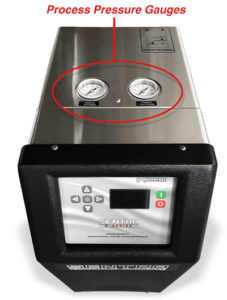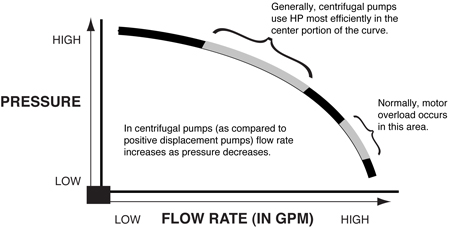
Temperature control units are used in industrial or plastic processing to regulate circulating water temperature to a precise set point. Controlling temperatures is critical to making quality parts and expected outcomes.
To access the health of the process and the operation of the temperature control unit, one may believe the temperature display on the control panel is the only indicator.
However, an often forgotten indication of the performance of the temperature control unit is the pressure gauges.
All temperature control units manufactured by Advantage include a set of pressure gauges. These simple pressure reading gauges can tell much of the health of the unit and process. Five aspects of the process can be observed by the pressure gauges.
Why #1
The supply water pressure. With the unit off, both pressure gauges will indicate the water supply pressure available to the unit. Whether water supply is provided via the city, a well, a tower system or a chiller, water supply is important to the function of the unit. Water supply pressure is critical to retaining water in a liquid state at temperatures over 180°F. As operating set points increase over 180°F, water supply pressure must increase too, up to 55 PSI at 250°F. The minimum water supply pressure for unit operation is 20 PSI for temperatures up to 180°F. Inadequate water supply pressure contributes to premature failure of and increase maintenance in susceptible areas such as the shaft seal and heater.
Why #2
The pressure differential. This pump generated pressure is indicated by the To Process pressure gauge. Subtract the supply water supply pressure from the To Process pressure to calculate the pump generated pressure supplied to the process. When the pump generated pressure is close to the pressure required by the process, turbulent flow is established and heat transfer is optimized.
Why #3
The pump rotation. A centrifugal pump like those supplied in Advantage temperature control units must rotate in a specific direction. A correctly rotating pump is needed to create pressure and flow through the process. If the To Process and From Process gauges are reading close to the same pressure it is likely that the pump is not rotating correctly. Following proper lock out and tag out policy, simply reserving two incoming power wires at the unit’s disconnect switch will correct a backwards rotating pump. Proper pump rotation is clockwise as you are looking at the back of the motor and should also be verified by viewing the pump motor.
Why #4
 A motor overload condition. A fourth indication of the pressure gauges is a pump that is pumping more than it is rated for which could be causing an overload condition. If proper pump rotation has been verified, a low pressure differential across the two gauges can indicate a flow rate that is beyond the capability of the motor to provide which will cause the motor to trip on its over current protection. A valve in the discharge can be closed slightly to correct this issue. Verify performance by comparing the rated motor amps to the actual amps used by the pump motor during operation.
A motor overload condition. A fourth indication of the pressure gauges is a pump that is pumping more than it is rated for which could be causing an overload condition. If proper pump rotation has been verified, a low pressure differential across the two gauges can indicate a flow rate that is beyond the capability of the motor to provide which will cause the motor to trip on its over current protection. A valve in the discharge can be closed slightly to correct this issue. Verify performance by comparing the rated motor amps to the actual amps used by the pump motor during operation.
Why #5
Water hammer. This is a destructive high pressure event created when a solenoid or other valve closes quickly. Commonly found on units with a solenoid valve used as the internal cooling value, the To and From process pressure gauges will spike to the extreme as the flow of water is suddenly stopped by the closing of the valve. Over time these frequent pressure spikes will break down seals and pipes and will increase maintenance on the system. Frequent water hammer in your system should be addressed.
![]() Contact Advantage or your local Advantage Representative for more information about temperature control units and process pressure. The To and From process gauges are valued indicators of overall system and unit health. An Advantage FYI is available to download.
Contact Advantage or your local Advantage Representative for more information about temperature control units and process pressure. The To and From process gauges are valued indicators of overall system and unit health. An Advantage FYI is available to download.
